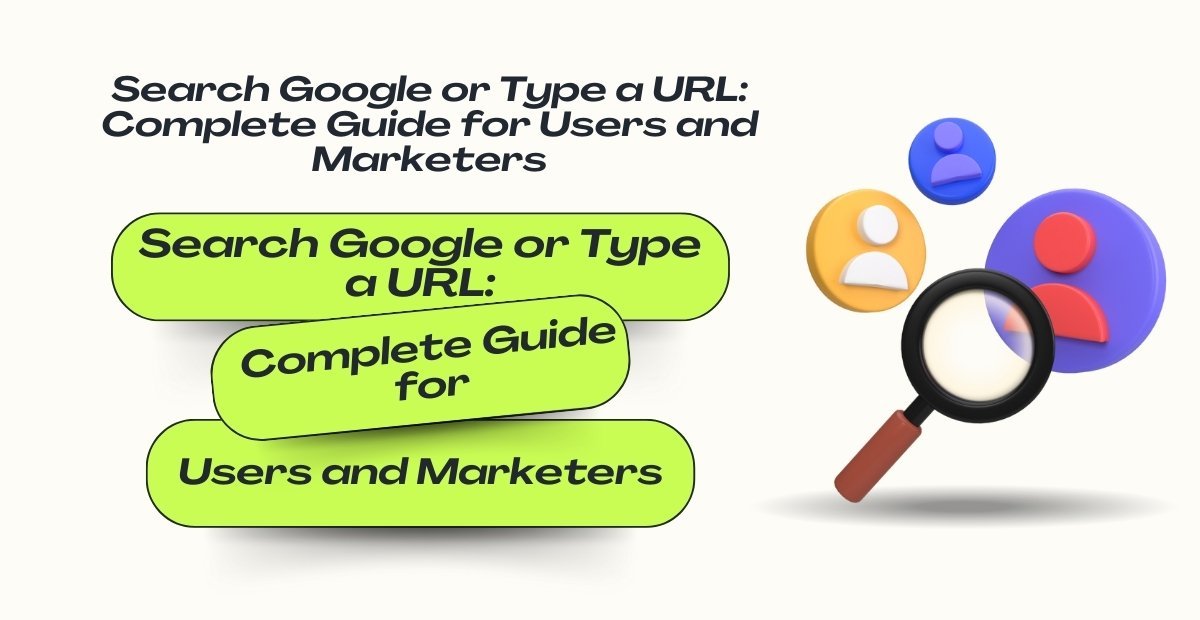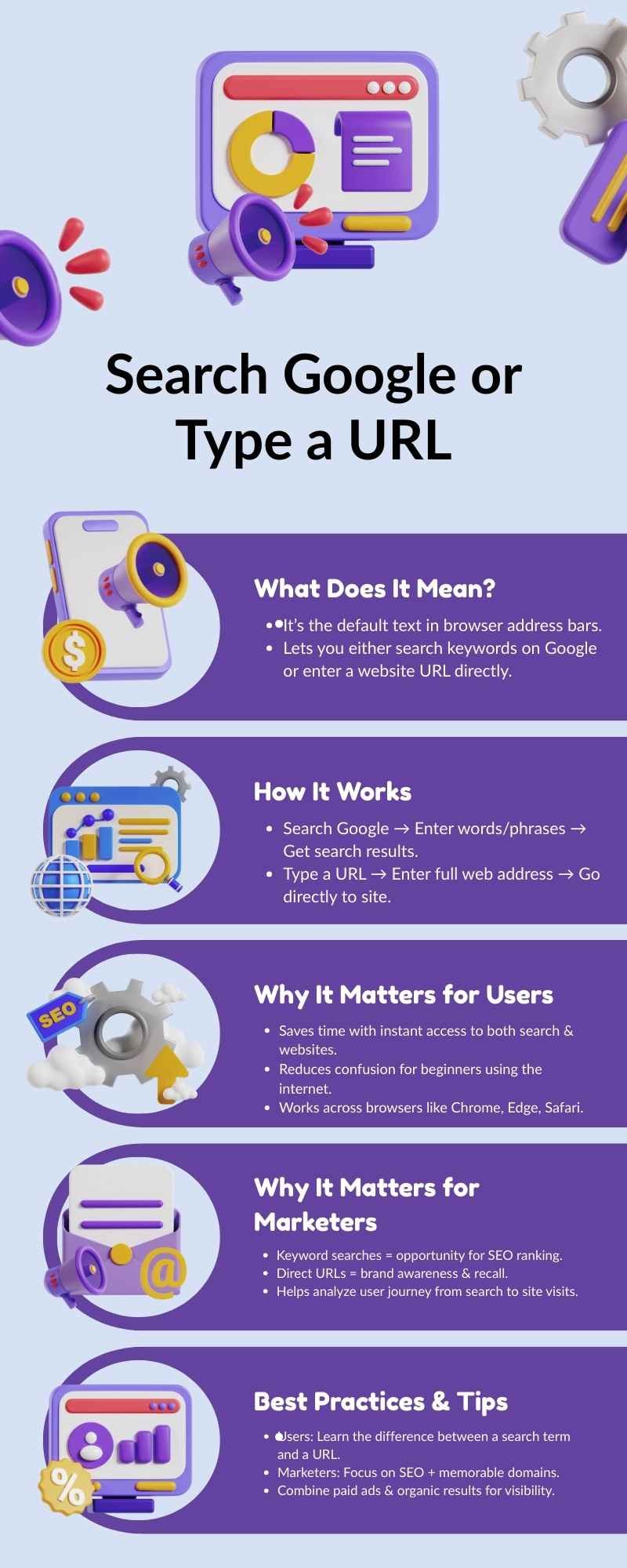
Search Google or Type a URL: Complete Guide for Users and Marketers
When you open a browser like Chrome, Safari, or Firefox, you often see the phrase “Search Google or Type a URL.” But what does Search Google or Type a URL mean? Simply put, it’s a prompt inside the browser’s address bar that gives you two choices: type a full website address (like www.example.com) or enter a search query directly. Instead of going to Google’s homepage first, the browser automatically runs your query through Google Search. This phrase, Search Google or Type a URL, highlights the convenience of modern browsers, which’ve merged the search bar and address bar into one seamless tool
What Does “Search Google or Type a URL” Mean?
When you open a modern browser, the phrase “Search Google or Type a URL” often appears in the main bar at the top. This single bar serves two important roles. First, it works as a search bar; if you type in a question or keywords, the browser sends your query to Google and displays results. Second, it functions as an address bar (URL bar) when you enter a website’s exact address, like www.example.com, it takes you directly to that page.
In the past, browsers separated these two functions, but today they are merged for convenience. This combined design saves time and makes browsing seamless, whether you’re searching for information or visiting a specific site. Understanding how the address bar vs search bar works helps users avoid confusion, and it shows why the prompt “Search Google or Type a URL” explained is more than just a reminder; it’s a guide for effortless web navigation.
How to Use “Search Google or Type a URL” Efficiently
When you open a browser, the address bar often shows the phrase “Search Google or Type a URL.” It’s not just a prompt; it’s a powerful tool that saves time if you know how to use it efficiently.
1. Searching Queries on Google
If you want information, type your query directly in the bar. For example, entering the best restaurants in Dubai instantly takes you to Google search results. This method is faster than opening Google separately.
2. Entering Direct Website Links
When you already know the website address, simply type the URL. Writing www.pixoku.com will open the site directly, skipping search results. This is where “Search Google or Type a URL” shows its dual function: either search or navigate.
3. Autocomplete and Smart Suggestions
As you type, Google suggests popular searches or recent sites. These smart suggestions help you reach results faster while reducing typing errors.
Using the Search Google or Type a URL feature efficiently means knowing when to search, when to type, and how to use autocomplete for speed. Mastering this habit keeps your browsing quick, simple, and productive.

Key Differences Between Search and URL Entry
When you open a browser, you often face a choice: Search Google or type a URL. Both serve different purposes, and knowing when to use each can save time and improve your browsing experience. If you’re looking for information, products, or answers without knowing the exact website, search is the go-to. On the other hand, typing a direct web address is best when you already know the site you want to visit.
The main difference between search and URL lies in intent. Search is discovery-driven, while typing a URL is task-driven. Each option has strengths and drawbacks, as shown below:
| Option | When to Use | Pros | Cons |
| Search Google | When you don’t know the exact site or need broad information. | Quick access to multiple sources, suggestions, and related results. | Extra steps before reaching the right page; risk of ads or irrelevant results. |
| Type a URL | When you know the exact website address. | Fast, direct access without distractions; secure if the site is trusted. | Requires remembering the address; a small typo can block access. |
Common Mistakes People Make While Using It
When people use the “Search Google or Type a URL” bar, small errors can create big problems. Many of these mistakes seem harmless but can lead to wasted time, wrong information, or even unsafe browsing. Here are the most common mistakes Search Google or Type a URL users make:
- Typing keywords in the URL bar only – Instead of entering a full domain name, people type phrases like “best shoes online” in the URL field, which leads to unnecessary redirects.
- Entering fake or unsafe domains – One of the major wrong URL issues happens when users type misspelled web addresses. It can lead them to phishing or scam sites.
- Confusing search results with direct sites – Many users click on ads thinking they are official websites, when in reality they are promoted results.
- Skipping the “https://” security check – Ignoring whether a site has SSL security can expose users to malware or data theft.
- Mixing spaces or symbols in URLs – Even a small typo like a missing dot or extra slash can cause errors or open the wrong site.
- Not recognizing auto-suggestions – Instead of choosing correct suggestions, users often retype everything, which increases mistakes.
Avoiding these common mistakes, search Google, or typing a URL ensures smoother browsing, keeps data secure, and saves time online.
Tips to Get the Best Results from “Search Google or Type a URL”
When you open your browser, the first thing you see is often the bar that says Search Google or Type a URL. Mastering how you use this feature can save time, improve accuracy, and keep your browsing secure. Here are some practical tips to get better results.
Start by using long-tail keywords when typing queries. Instead of searching for real estate in Dubai, try rental yields in Dubai real estate 2025. Longer, specific terms give you more relevant results and reduce wasted clicks.
Next, bookmark frequently visited URLs. If you often return to the same websites, such as Gmail, a news portal, or your company’s dashboard, saving them avoids repetitive typing and ensures quick access.
Security should never be overlooked. Always check for HTTPS before entering a URL, especially when shopping, banking, or logging in. A secure site protects your data from unwanted breaches.
By combining smart search habits with efficient shortcuts, you’ll transform the way you use the Google Search or type in the URL bar.
Key Takeaways
- Use long-tail keywords for better accuracy.
- Bookmark URLs you use daily.
- Always confirm HTTPS for safe browsing.
Why “Search Google or Type a URL” Matters for SEO and Marketing?
When you open a browser, the line that says “Search Google or type a URL” may look like a simple instruction. But for marketers, it holds powerful insights into how people behave online and how brands can shape their digital strategies.
How It Impacts User Search Behaviour : That phrase represents two distinct actions: typing a brand’s URL directly or entering a query into Google. Users who search tend to explore, compare, and discover new brands, while those typing a URL often already have brand loyalty. For SEO, this distinction shows whether traffic comes from awareness-driven searches or from an established customer base.
Brands Optimizing for Typed vs. Searched Queries: Some businesses thrive on direct traffic because their brand name is strong enough for users to type it straight into the bar. Others rely heavily on search queries. Optimizing for both is essential: search-driven content captures new users, while consistent brand presence builds trust that leads to direct visits.
Direct Traffic vs. Organic Search: Marketers often compare direct traffic with organic search to understand intent. Direct traffic suggests a brand is top-of-mind. Organic search, on the other hand, highlights how well a business ranks for queries around products or services. Both matter in shaping long-term growth strategies.
A Case Example
Take a business that ranks high for its branded keywords. When users type “XYZ Shoes” instead of searching for “running shoes,” it shows how brand authority drives direct engagement. By balancing SEO for broad keywords with brand-focused campaigns, businesses maximize visibility.
Conclusion
Browsing the web doesn’t have to feel complicated. The Search Google or Type a URL guide shows us how this single feature blends search power and direct navigation into one simple action. Instead of juggling multiple steps, you can either enter keywords to explore or type a specific URL to head straight to your destination. This dual function saves time, reduces confusion, and makes browsing more intuitive for everyone from beginners to experienced users. The key takeaway is that small features often have the biggest impact on efficiency. By using Search Google or Type a URL wisely, you turn every session into a smoother, faster experience. Pair it with smart browsing tips, like using concise search terms or bookmarking frequently visited sites, and you’ll unlock even more value. In short, mastering this feature ensures you stay productive, informed, and just a click away from what matters most.




Add Comment